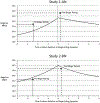Negative affect and binge eating: Reconciling differences between two analytic approaches in ecological momentary assessment research
- PMID: 28851137
- PMCID: PMC8686165
- DOI: 10.1002/eat.22770
Negative affect and binge eating: Reconciling differences between two analytic approaches in ecological momentary assessment research
Abstract
Objective: Ecological momentary assessment (EMA) research has produced contradictory findings regarding the trajectory of negative affect after binge-eating episodes. Given the clinical implications, the objective of the current study was to reconcile these inconsistencies by comparing the two most commonly employed statistical approaches used to analyze these data.
Method: Data from two EMA studies were analyzed separately. Study 1 included 118 adult females with full- or subthreshold DSM-IV anorexia nervosa. Study 2 included 131 adult females with full-threshold DSM-IV bulimia nervosa. For each dataset, the single most proximal negative affect ratings preceding and following a binge-eating episode were compared. The times at which these ratings were made, relative to binge-eating episodes, were also compared.
Results: The results indicate that the average proximal pre-binge ratings of negative affect were significantly higher than the average proximal post-binge ratings of negative affect. However, results also indicate that the average proximal post-binge ratings of negative affect were made significantly closer in time to the binge-eating episodes (∼20 min post-binge) than the average proximal pre-binge ratings of negative affect (∼2.5 hr pre-binge). A graphical representation of the results demonstrates that the average proximal pre-binge and post-binge ratings map closely onto the results of previous studies.
Discussion: These data provide one possible explanation for the inconsistent findings regarding the trajectory of negative affect after binge eating. Moreover, they suggest that the findings from previous studies are not necessarily contradictory, but may be complementary, and appear to bolster support for the affect regulation model of binge eating.
Keywords: affect regulation; binge eating; ecological momentary assessment; negative affect.
© 2017 Wiley Periodicals, Inc.
Conflict of interest statement
CONFLICT OF INTEREST
The authors indicate no conflict of interest.
Figures

Similar articles
-
Negative affect and binge eating: Assessing the unique trajectories of negative affect before and after binge-eating episodes across eating disorder diagnostic classifications.Int J Eat Disord. 2022 Feb;55(2):223-230. doi: 10.1002/eat.23648. Epub 2021 Dec 8. Int J Eat Disord. 2022. PMID: 34877679 Free PMC article.
-
Examining intra-individual variability in food-related inhibitory control and negative affect as predictors of binge eating using ecological momentary assessment.J Psychiatr Res. 2020 Jan;120:137-143. doi: 10.1016/j.jpsychires.2019.10.017. Epub 2019 Oct 26. J Psychiatr Res. 2020. PMID: 31677551 Free PMC article.
-
The role of affect in the maintenance of binge-eating disorder: Evidence from an ecological momentary assessment study.J Abnorm Psychol. 2020 May;129(4):387-396. doi: 10.1037/abn0000517. Epub 2020 Mar 26. J Abnorm Psychol. 2020. PMID: 32212743 Free PMC article.
-
Emotion Regulation in Binge Eating Disorder: A Review.Nutrients. 2017 Nov 22;9(11):1274. doi: 10.3390/nu9111274. Nutrients. 2017. PMID: 29165348 Free PMC article. Review.
-
Negative affect, interpersonal perception, and binge eating behavior: An experience sampling study.Int J Eat Disord. 2015 Sep;48(6):715-26. doi: 10.1002/eat.22410. Epub 2015 May 6. Int J Eat Disord. 2015. PMID: 25946681 Review.
Cited by
-
An examination of the interpersonal model of binge eating over the course of treatment.Eur Eat Disord Rev. 2020 Jan;28(1):66-78. doi: 10.1002/erv.2700. Epub 2019 Sep 9. Eur Eat Disord Rev. 2020. PMID: 31497914 Free PMC article.
-
Self-control, food choices, and affective well-being in daily life: an experience sampling study.J Behav Med. 2025 Jun;48(3):430-441. doi: 10.1007/s10865-025-00549-y. Epub 2025 Feb 20. J Behav Med. 2025. PMID: 39976855
-
Converging vulnerability factors for compulsive food and drug use.Neuropharmacology. 2021 Sep 15;196:108556. doi: 10.1016/j.neuropharm.2021.108556. Epub 2021 Apr 20. Neuropharmacology. 2021. PMID: 33862029 Free PMC article. Review.
-
COVID-19 and Eating Problems in Daily Life: The Mediating Roles of Stress, Negative Affect and Posttraumatic Stress Symptoms.Psychol Rep. 2023 Feb;126(1):34-51. doi: 10.1177/00332941211045315. Epub 2021 Nov 16. Psychol Rep. 2023. PMID: 34784823 Free PMC article. Review.
-
The role of habit in maintaining binge/purge behaviors: An ecological momentary assessment study.Int J Eat Disord. 2024 May;57(5):1160-1171. doi: 10.1002/eat.24070. Epub 2023 Sep 30. Int J Eat Disord. 2024. PMID: 37776547 Free PMC article.
References
-
- Berg KC, Crosby RD, Cao L, Crow SJ, Engel SG, Wonderlich SA, & Peterson CB (2015). Negative affect prior to and following overeating-only, loss of control eating-only, and binge eating episodes in obese adults. The International Journal of Eating Disorders, 48(6), 641–653. 10.1002/eat.22401. - DOI - PMC - PubMed
MeSH terms
Grants and funding
LinkOut - more resources
Full Text Sources
Other Literature Sources
Research Materials

